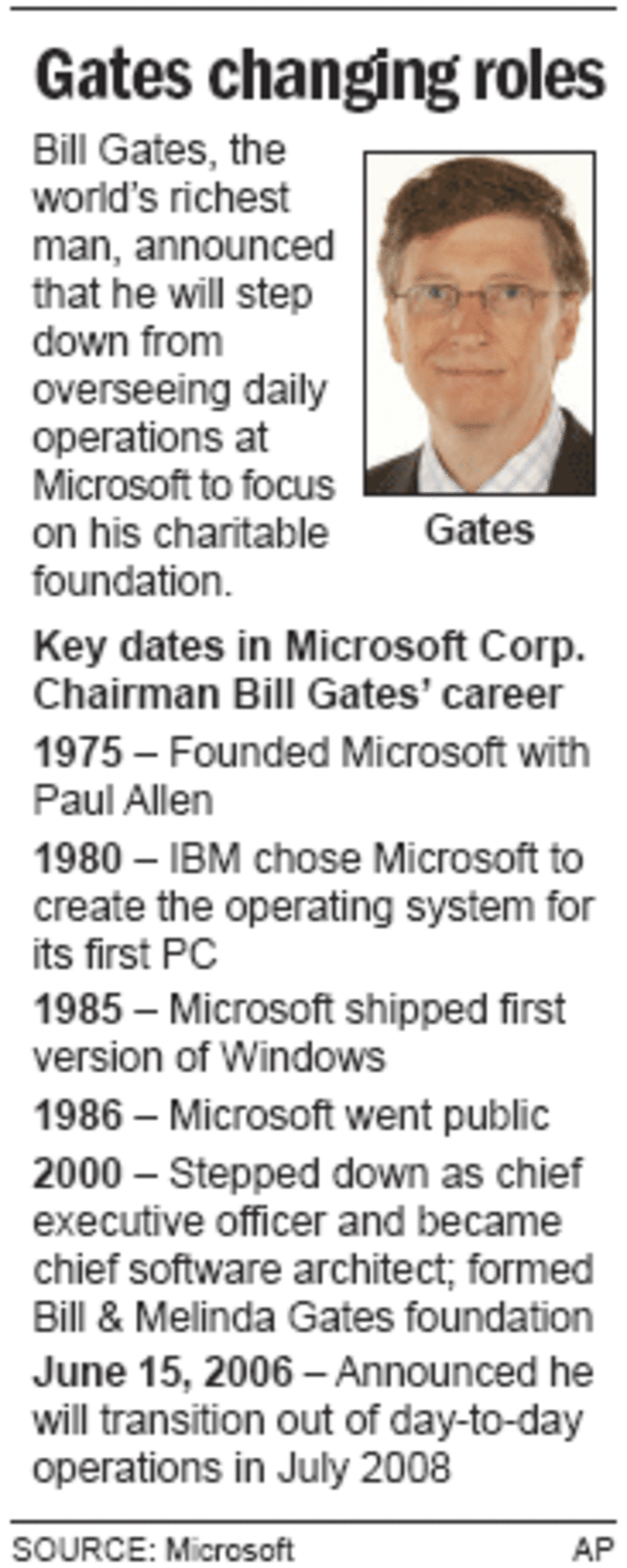The man who has come to define the PC revolution has decided to walk away — very slowly — from his creation. Microsoft Chairman William H. Gates III said June 15 that he will give up his day-to-day role at the company in two years to focus on giving his vast riches away through the $29 billion Bill & Melinda Gates Foundation.
“Just as Microsoft took off in ways I never expected, so has the work of the Foundation, and it's growing rapidly,” Gates, 50, said in a press conference announcing the news. “With the early successes comes the challenge of scaling up and delivering these new approaches to everyone who can benefit.” Gates says he plans to remain Microsoft's chairman indefinitely.
This move is just the latest step in what will end up being a multiyear and multistage period of disengagement. Gates gave up the chief executive job to his longtime friend and partner-in-arms Steve Ballmer six years ago. He seems determined not to upset investors and employees with too sudden a departure from a company so closely identified with him. At the same time, Gates says it's important for folks to get “beyond the myth of one person doing a high percentage of things.”
(MSNBC.com is a joint venture of Microsoft and NBC Universal News.)
Room for fresh ideas
Indeed, most analysts don't see the move as disruptive. If anything, it's a positive for the company, creating the possibility of fresh thinking in an organization seen by many in the tech industry as being hung up on the past. Gates, more than anyone else, ushered in the era of the PC and the software that went with it. With Microsoft's Windows and Office monopolies, the company became the dominant tech company in the latter part of the 20th century.
But in the last few years, it has become clear that the technology industry is entering a new epoch. The Internet is becoming the focal point — and Microsoft, with its dependence on packaged software, finds itself chasing upstarts such as Google in search, Apple in digital music, and salesforce.com in online business applications.
As much as Gates is identified with the PC era, he's also a lightning rod for many of Microsoft's recent problems. Case in point: The next version of its operating system software, Windows Vista, will arrive for most users next year, more than five years after the previous version of Windows was launched.
Recent setbacks
Internally, some blamed Gates for pushing developers to do too much, leading the company two years ago to reset plans for the product and scale back its ambition. Microsoft last year belatedly launched a strategy to flood the market with new online services to match or leapfrog those being created rapid-fire by the likes of Google and Yahoo! Microsoft has often struggled internally because so many decisions need Gates's blessing. The company has reorganized over the years to put less decision making in front of Gates.
As he moves on, Gates is expected to have a tremendously positive effect on the world through his foundation work. “While Gates's impact and role with Microsoft is and will still be very important, his business role pales in comparison to the amount of good he can do as head of the foundation,” says Tim Bajarin, president of tech consultancy Creative Strategies.
At the foundation, Gates says his role will be much like his role as chairman at Microsoft. “I look at that in a lot of ways like the work at Microsoft, you need people there who are experts in their field,” Gates says. He won't, for example, displace Foundation CEO Patty Stonesifer.
The two-year transition will see the ascension of Ray Ozzie, one of three chief technical officers at Microsoft, who will slide into Gates's job as chief software architect. Ozzie, who created Lotus Notes, joined Microsoft in April, 2005, when Microsoft acquired a small collaborative software startup he launched called Groove. He immediately takes Gates's title of chief software architect and will become the lead technology visionary for the world's largest software company.
The top execs who've heard of Gates's pending departure are eager to step into their expanded roles, Ballmer says. “It's not like anybody is saying, 'Oh, isn't this a great day,'” Ballmer says. “On the other hand, it's not a bad day. You have a lot guys who say, 'Hey, this is a chance for me to do even more, for me to step up.'”
None more than Ballmer himself. For the first time in his 26 years with Microsoft he will no longer have Gates at his side. “I feel a lot of emotion today, given the incredibly close working relationship Bill and I have,” Ballmer said during the press conference. Gates too seemed to be touched as he reflected back on his decades at the helm of Microsoft. “I don't know what it will feel like not to come in and work my 10 to 11 hours,” he said.
From duo to soloists

Gates first brought up the idea of the shift to Ballmer in 2004. “When Bill first talked to me about the possibility, I was mostly quiet, I think,” says the usually gregarious Ballmer. It was just before he went off on vacation, and it took him some time to ponder the implications. “I wound up saying, 'Yeah, I see how we can make this work',” Ballmer says. "It wouldn't have been my preferred path to being thinking about this on this vacation.”
It wasn't until March, though, that Gates began to get serious about making the move. He told the board in a meeting then that he'd have a decision by mid-June. He made that decision on June 13, just before a conference call with directors.
The duo, possibly the most successful business combination in history, set about deciding how to divvy up Gates's tasks if he followed through with his plans. And Ballmer began to think about how his role as the sole leader of the software giant would change.
On a white board, they scrolled out a list of Gates roles. Ballmer dubbed one of them “expansionistic thinking.” It's the idea of getting Microsoft employees to innovate and create new opportunities for the company. “It might not be obvious who should pick up that opportunity,” Gates says. “He put his name next to that, which I thought was brilliant.”
